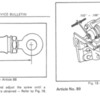I had new clutch master and slave cylinders installed last summer and everything worked fine.
I also note that the new slave cylinder and new bracket don't use a return spring.
If I try to start the car in gear with the clutch pedal fully depressed, the car moves forward (1st gear). The clutch is not fully disegaging. The only adjustment I seem to have is to turn the nut on the actuating rod. Is that correct? How far do I turn the nut, just enough to not have the car move forward?
Original Post


